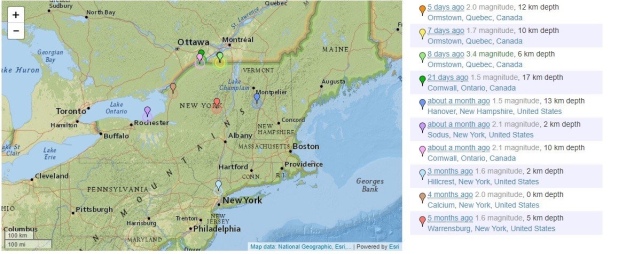By Mark Horowitz January 21, 2020
There are some parts of the planet where earthquakes have come to be expected, because they sit near fault lines and have them on a regular basis, like California, for example, but for most of the world, this type of seismic activity is not very common. The Northeast region of the continent of North America experiences earthquakes very rarely, but in recent months there has been an unusually high level of seismic activity in this part of the world.
The most recent quake registered as a 3.3 magnitude and occurred around 5:37 a.m on Monday of last week, with an epicenter roughly 10 miles south of Ormstown, Canada, just along the border. Luckily, there was no damage or injuries reported as a result of the quake, but it did shake the homes of many residents, leaving them shocked and alarmed by this uncommon natural occurrence.
As you can see in the map below, provided by Earthquake Track, there have been a series of quakes in the same region in the past few months.

Photo: Screenshot
It seems that many of the quakes had an epicenter that was just along the border between the United States and Canada, with only two occurring a good distance away from the border. It is not clear what is causing this recent flurry of seismic activity, although there are a variety of different theories.
These recent quakes also come at a time of heightened volcanic activity around the earth, with many eruptions taking place around the world in the past month. Some researchers speculate that the earthquakes and volcanic eruptions could somehow be linked, but this is mostly speculation, as it has not been significantly proven that volcanic eruptions can trigger other earthquakes or eruptions a long distance away, although it has been proven that this phenomenon takes place if volcanoes are in close proximity.
Meanwhile, many activists suggest that the quakes have been caused by the practice of “hydraulic fracturing,” which is a natural gas extraction method that has become extremely controversial for its environmental impacts. Also known as “fracking,” this extraction process involves drilling down into the earth, then directing a high-pressure water mixture at the rock below to release the gas inside. Water, sand, and chemicals are injected into the rock at high pressure, which allows the gas to flow out to the head of the well. Wastewater produced from this process is highly toxic and filled with a variety of chemicals.
The government in the UK recently issued a temporary ban on fracking throughout the country until scientists can prove that it is actually safe. The ban came in response to concerns that fracking sites were poising water supplies and disrupting the earth’s crust in a way that was causing a large number of earthquakes.
No comments:
Post a Comment